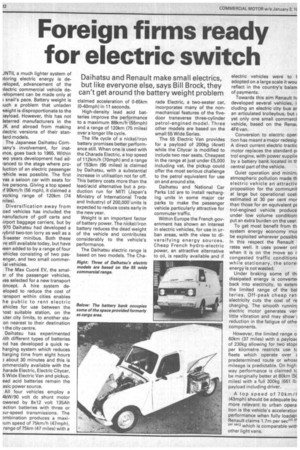Foreign firms ready for electric switch
Page 34

If you've noticed an error in this article please click here to report it so we can fix it.
Daihatsu and Renault make small electrics, but like everyone else, says Bill Brock, they can't get around the battery weight problem
JNT1L a much lighter system of itoring electric energy is de/eloped, advancement of the ?lectric commercial vehicle de(elopment can be made only at snail's pace. Battery weight is iuch a problem that unladen weight is disproportionate to the myload. However, this has not ieterred manufacturers in the JK and abroad from making )lectric versions of their stanlard models.
The Japanese Daihatsu Com)any's involvement, for instince, goes back to 1965. Within wo years development had adfenced to the stage where proiuction of an electric passenger Thiele was possible. The first vas a saloon car with seats for ive persons. Giving a top speed 90km/h (56 mph), it claimed a vorking range of 120km (74 niles).
Diversification away from oad vehicles has included the nanufacture of golf carts and rirport baggage carriers, but by 970 Daihatsu had developed a lybrid two-ton lorry as well as a 5-seater minibus. Both these re still available today, but have leen added to by a range of four • ehicles consisting of two pasenger, and two small commerial vehicles.
The Max Cuore EV, the smal
ar of the passenger vehicles, as selected for a new transport Oncept. A hire system de eloped to reduce the cost of -ansport within cities enables he public to rent electric ehicles for use between the -lost suitable station, on the uter city limits, to another staon nearest to their destination the city centre.
Daihatsu has experimented rith different types of batteries nd has developed a quick reharging system which reduces harging time from eight hours ) about 30 minutes and this is ommercially available with the harade Electric, Electric Citycar, 5 Wide Electric Van and pickup. ead acid batteries remain the asic power source.
All four vehicles employ a 4kW/90 volt dc shunt motor owered by 8x12 volt 135Ah .action batteries with three or )ur-speed transmissions. The Dmbination produces a maxi turn speed of 75km/h (47mph range of 75km (47 miles) with a
claimed acceleration of 0-65km (0-40mph) in 11 seconds.
High-density lead acid batteries improve the performance to a maximum 88km/h (55mph) and a range of 120km (75 miles) over a longer life cycle.
The life cycle of a nickel/iron battery promises better performance still. When one is used with the Charade Electric, a top speed of 112km/h (70mph) and a range of 153km (95 miles) is claimed by Daihatsu, with a substantial increase in utilisation not far off. This battery costs more than the lead/acid alternative but a production run for MITI (Japan's Ministry of International Trade and Industry) of 200,000 units is expected to reduce costs early in the new year.
Weight is an important factor of battery power. The nickel/iron battery reduces the dead weight of the vehicle and contributes considerably to the vehicle's performance.
The Daihatsu electric range is based on two models. The Cha rade Electric, a two-seater car, incorporates many of the nonmechanical features of the fivedoor transverse three-cylinder petrol-engined model. Three other models are based on the small 55 Wide Series.
The 55 Electric Van provides for a payload of 200kg (4cwt) while the Citycar is modified to include two rear seats. Cheapest in the range at just under £5,000 including vat, the pickup could offer the most serious challenge to the petrol equivalent for use on and around site.
Daihatsu and National Car Parks Ltd are to install recharging units in some major car parks to make the passenger vehicle particularly attractive for commuter traffic.
Within Europe the French government has shown an interest in electric vehicles, for use in urban areas, with the view to diversifying energy sources. Cheap French hydro-electric power, an attractive alternative to oil, is readily available and if electric vehicles were to I adopted on a large scale it wou reflect in the country's balani of payments.
Towards this aim Renault hi developed several vehicles, i cluding an electric city bus ar an articulated trolleybus, but yet only one small commerci vehicle, based on the Rena. 4F6 van.
Conversion to electric oper tion has meant a major redesigl A direct current electric tractic motor replaces the standard p: trol engine, with power supplie by a battery bank located in th central part of the vehicle.
Quiet operation and minimi atmospheric pollution made th electric vehicle an attractiv proposition for the communit at large but operational cost: estimated at 30 per cent mor than those for an equivalent pE trol-engined vehicle produce under low volume condition: put an extra burden on the user.
To get most benefit from th system energy economy mw be exploited wherever possiblE In this respect the Renault rates well. It uses power onl when it is on the move so i congested traffic conditions while stationary, the store, energy is not wasted.
Under braking some of th dissipated energy is convertei back into electricity, to exteni the limited range of the bat teries. Off-peak cheap rat: electricity cuts the cost of re charging. The smooth runnini electric motor generates ver little vibration and may show reduction in the fatigue of othe components.
However, the limited range o 60km (37 miles) with a payloac of 230kg allowing for two stops per kilometre restricts use tc fleets which operate over C predetermined route or whom mileage is predictable. On high way performance is claimed tc be marginally better at 80km (5( miles) with a full 300kg (661 lb payload including driver.
A top speed of 7 Okm/) (43mph) should be adequate bu more relevant to urban opera tion is the vehicle's acceleratior
per se when fully loaded Renault claims 1.7m per sec215.5f which is comparable with other light vans.












































































